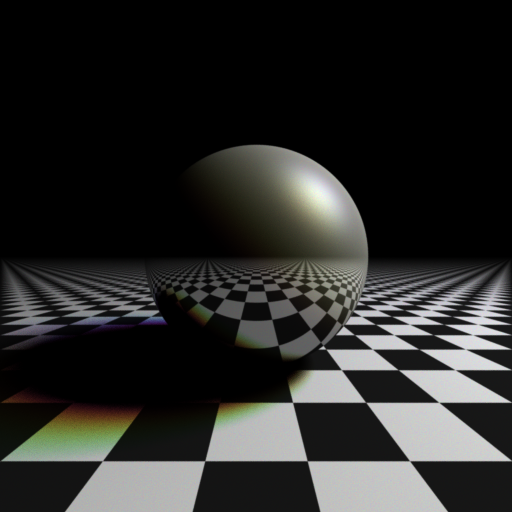new file: examples/dof.png
new file: examples/fuzzy.png
new file: examples/moblur.png
new file: examples/soft.png
Way back in, er, apparently 1999, I wrote a very simple ray-tracer. It traces spheres. Nothing but spheres. Shiny spheres.
If you've seen my excel-ray-tracer repository, you may have guessed that I like ray-tracers. They're simple to write yet can produce remarkably pretty results. They allow all kinds of extensions, from highly-optimised code through support for complicated geometric primitive, or fantastic textured, or whatever.
This tracer has none of that. On the other hand, it's simple and straightforward, and (looking back) easy-to-read.
I have since decided that I would like to experiment with all the techniques I didn't include in the very basic original renderer. We now have:
-
spheres Generates a whole pile of shiny spheres
-
dof Generates a row of spheres on a checkerboard plane (how original!), in order to demonstrate depth-of-field, and a little bit of antialiasing.
-
soft Demonstrates soft shadows, including a bit of coloured shadows.
-
fuzzy Shows off fuzzy reflections. The five images are without fuzz, two different levels of fuzz, and then fuzz with only horizontal and vertical elements. To be honest, I'm a bit underwhelmed by this one.
-
moblur Demonstrates motion blur. It's like 'dof', only with the balls moving away from/towards the viewer. I also turned off the depth-of-field effect in order to make sure the blurriness basically comes from the motion. I don't think the effect is super-impressive, but it's kind of nice. I prefer it to the fuzzy reflections.
-
trans Deals with transparency and refractions. I don't particularly like it, since refraction at realistic levels is a very powerful effect which makes it difficult to make it looks nice.
-
dof2 This is really a combination of 'dof' and 'soft', applying soft shadows to the 'dof' image.
I've provided example output for the cases that I feel worked well.
(If you want the pretty-much-original version, use the tag "original-spheres")
Compile it with build.sh. For the original, run the produced executable "spheres". For the depth-of-field demonstration, run "dof". etc. You will need to have libpng installed. A PNG file should appear in the current directory. You can alter the image produced by modifying the source file, recompiling and rerunning. How high tech!
I love writing these disclaimers. This is code I wrote 15 years ago, and then hacked up to have new features added. If I were doing this kind of thing now, I wouldn't write it in C, and I can't even remember which features are in proper C and not C++. As I have limited spare time, I'm just hacking the features in and moving on to the next one, rather than creating a coherent and neat ray-tracer design. It's even got special memory management (i.e. do a malloc and never bother with free). Don't read too much into the style - this is not quality code!
